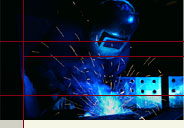
For the first time ever my car left me stranded on the morning of 10/28/07. I was coming off a night shift and it was raining. Could've been worse, I had not made it out of the parking lot yet. Three minutes later and I would've been on the Interstate. I tried checking my fusible links but it was dark, I did not have a flashlight (doh!) and it was raining. There was gas in the tank. Time to use my AAA Plus membership. I was home and in bed within the hour. The tow truck driver even helped me push my car into my garage.
I highly recommend getting AAA Plus if you drive older cars like me. The upgrade to Plus gets you free towing for a 100 mile distance. The basic AAA membership only gets you a free tow for five miles. One tow and your membership is paid for, not to mention the peace of mind of having a AAA phone number that works no matter where you travel.
Car engines need three things to run - fuel, air, and spark. When a car suddenly dies under normal operating conditions, without any metal grinding sounds, clanking noises, smoke or steam, this usually indicates a lack of fuel or a lack of spark to me. The number one cause of lack of fuel is an empty gas tank. The number one cause of roadside breakdown is the car engine overheating, usually caused by a leaky hose or broken belt. That will usually lead to steam and abnormal noises.
My car had died like it was shot in the head, suddenly shut down, would turn over but not fire at all. I still had battery power, all the idiot lights were on. Since my car usually fired right up within a second or two, I decided not to drain my battery or burn out my starter motor by continuously cranking the engine.
My first clue occurred while I was sitting in the car, in the rain, waiting for the tow truck. With the ignition on, there was a very strange erratic, repetitive clicking noise coming from inside the right rear wheel housing, behind the passenger seat.
This clicking noise gradually died out, like a short circuit that was partial then complete. Once home, I searched through my FSM (factory service manual), and posted a question on the Repair Forum at z31.com. I learned that the clicking sound was coming from the location of the fuel pump relay. Why the Nissan engineers decided to stick this relay inside the car and behind some interior trim pieces I'll never know.
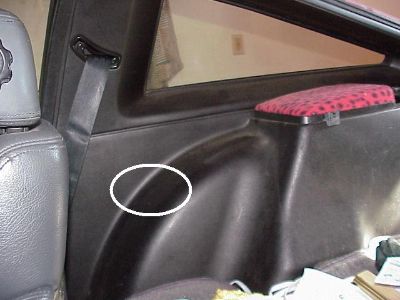 The fuel pump relay is located under this trim piece, and is where I heard the clicking noise after the car died. Then the clicking noise died out. The fuel pump relay is located under this trim piece, and is where I heard the clicking noise after the car died. Then the clicking noise died out.
Also, I noticed that with the ignition on, the familiar buzz of my fuel pump coming from behind my head was absent. So between the clicking of the fuel pump relay and the silence of the fuel pump, I felt fairly confident I was dealing with a fuel delivery problem. I ended up being wrong.
Always check the basics first. There was fuel in the tank. The fusible links under the hood looked good. I got my hopes up a little when I saw there was a fuse labeled "fuel pump" in the fuse box near the driver's left foot, under the side kick panel.
 This 10A fuse goes to the fuel pump, and was not burnt out. Pull out the fuse to check it visually. I used needle nose pliers. Be gentle.The metal core inside the fuse should be solid. Burnt fuses are usually obvious. This 10A fuse goes to the fuel pump, and was not burnt out. Pull out the fuse to check it visually. I used needle nose pliers. Be gentle.The metal core inside the fuse should be solid. Burnt fuses are usually obvious.
Next I decided to see if any stored error codes showed up at the Electronic Control Unit (ECU) which is basically the car's computer brain. The ECU is located behind the kick panel on the passenger side.
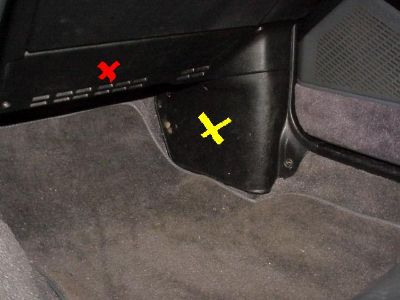 These two trim pieces come out with four of five screws. Remove red first, the ECU is behind the yellow X These two trim pieces come out with four of five screws. Remove red first, the ECU is behind the yellow X
The ECU was held in place by one screw shown below. The opposite end of the ECU was wedged behind a clamp.
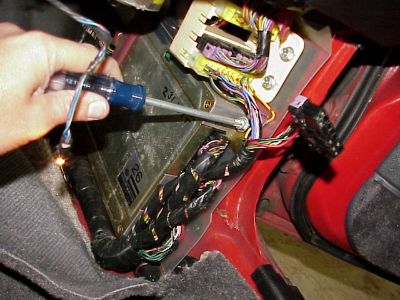 Notice the light next to my thumb. This was the interior light attached behind the red X trim piece, and made a decent work light. Notice the light next to my thumb. This was the interior light attached behind the red X trim piece, and made a decent work light.
I was anticipating error code number 22 in Mode III for an open fuel pump circuit. Boy, was I wrong.
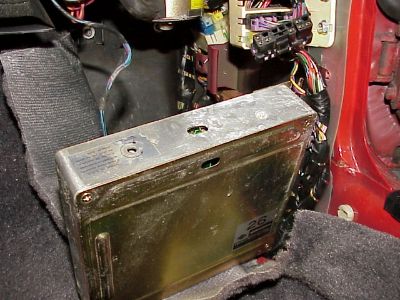 Oh, oh, the corrosion stains on the outside of the ECU were not a good sign. Oh, oh, the corrosion stains on the outside of the ECU were not a good sign.
The error codes are pulled by counting the number of flashes from a red and green LED in the little oval opening on the side of the ECU. My LED's stayed on constantly and never blinked, which turned out to be a sign of a bad ECU. One little tip - if the car won't start but will turn over, then crank the engine for at least two seconds before trying to pull the codes.
I took the four cover screws off for a peak inside the old ECU. A little bit of static electricity can ruin a circuit board, so ground yourself first.
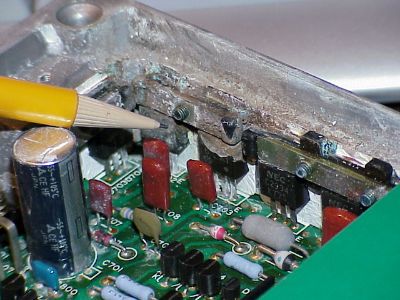 There was an area of bad corrosion along this edge. The rest of the insides of the ECU looked pristine. There was an area of bad corrosion along this edge. The rest of the insides of the ECU looked pristine.
Fortunately, I had stashed away a spare ECU that I bought on the Internet a long time ago. Nevermind that it took me two hours of opening every box in my garage to find it, lolam. Having a spare or back-up ECU for a car this old is a good idea as a diagnostic tool, and in this case it saved me from unnecessarily replacing other parts.
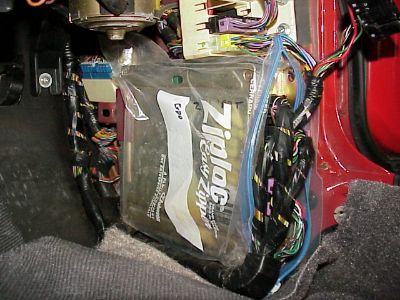 I did not see any heat sink issues with the ECU, so I installed the new ECU inside a quart plastic bag for extra protection. I did not see any heat sink issues with the ECU, so I installed the new ECU inside a quart plastic bag for extra protection.
Not unusual for a mechanic to rack up over a thousand dollar bill replacing sensors and parts controlled by the ECU, when the ECU itself is bad. Conversely, a malfunctioning sensor can ground out the ECU's reference voltage for that sensor. This can can cause the ECU LED lights to lock up or appear bad in diagnostic mode, since the same power supply that creates the reference voltage also runs the ECU.
I plugged in my "new" ECU. With the ignition key on I could instantly hear the familiar buzz of my fuel pump. The car fired right up and ran BETTER than before. On the road, the car was pulling much harder. I am a natural born skeptic but there was definitely a very real change for the better.
I have no idea which component controlled by the new ECU improved the car's performance so much. I had never tried to pull error codes from this car before. Among many other things, the ECU controls the ignition system's spark and timing, and the fuel injection pulse. The ECU continually receives signals from a myriad of sensors and then actively manages engine function through a variety of output devices. The system failure that eventually shut down the car seemed to be the fuel pump.
Here is some advice passed onto me from a full time ECU engineer, who deals with these issues more often in a day than I will in a lifetime. Nissan ECU's are remarkably hardy. He claims that 95% of the time it is not the ECU that is malfunctioning, but a short circuit from a faulty sensor or output device. If the ECU self diagnostic check does not work, i.e. the ECU LED lights are always on, or don't come on, then unplug anything under the hood that has a sensor one at a time and check the ECU each time in between. Try unplugging the PTU, the IAAC, the CAS, the MAS, etc. If the ECU lights up or starts to blink after unplugging a specific component, then that is where a fatal short may have burned a trace back at the ECU. Repair or replace that sensor or component first.
If all of the above fails and the ECU is still not working, then swap in a known or good ECU, or have the ECU tested out of the car. Another quick and dirty test is to simply take a look inside (ground yourself against static electricity) the ECU. The cover is easily removed. If there is some obviously melted stuff then that is a problem. Apparently, my ECU was in those five percent of cases when the ECU itself was bad.
Based on the improvement with the new ECU, my old ECU was not providing optimal performance even before the car stopped running. Probably a gradual decline in performance occurred over time as the corrosion built up. My butt dyno registered about a ten horsepower gain with the new ECU, lolam.
My old ECU looked repairable. I used Google and decided to give Auto Computer Supply a try. Unfortunately, I cannot recommend them.
They answered my E-mail inquiry the same day and their price was competitive. Once they had my ECU in their possession, things changed.
Their technician and manager called me three times in one day to tell me that my ECU had "major damage." However, they said they would still try to fix it and they promised to "not leave me hanging." They promised to find me a new/used ECU if this one turned out to be unrepairable. Turn around time was less than two weeks.
The ECU was still non-functional when I got it back. The paper seals they put on the outside of the ECU covered the self diagnostic lights so I could not see the error codes unless I removed the seals, which voided the warranty. The ECU threw the same "error code" as before, the ECU LED's stayed on all the time. I cracked open the ECU and nothing had been replaced. They looked like they made an effort to clean off some corrosion and that was it.
They would not answer my E-mails for two weeks, which was strange since before they had my money they answered my E-mail the same day. After two weeks and three E-mails, I telephoned and was dealt with somewhat of an attitude, but was ultimately promised a refund in 72 hours. Two weeks later after a couple of more phone calls, I did get a refund. Blech.

In a bizarre coincidence, exactly one year later to the day and for only the second time ever, the car would not start. Just like one year ago, the car had been again sitting out in the rain and the ECU went bad. When I tried to pull error codes the LED lights would just stay continually on.
I still could not locate any wet spots in the ECU compartment, but my windshield did leak to the interior, so I decided to seal the windshield on general principle.
I used waterproof clear silicone, the kind you buy at Home Depot and use a caulking gun to apply. I masked the edges of the windshield with painter's tape.
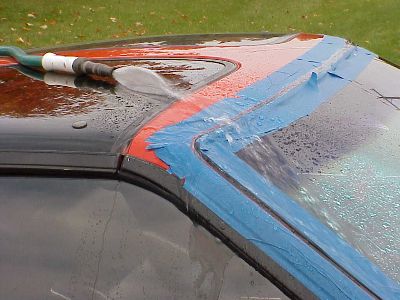 The interior stayed dry as a bone after I sealed the windshield with silicone adhesive. This was my test for dryness, before I removed the tape. The interior stayed dry as a bone after I sealed the windshield with silicone adhesive. This was my test for dryness, before I removed the tape.
This was not a professional looking job, but I just wanted to get any possible water leaks stopped for now until I had the car professionally painted, which could be who-knows-when?
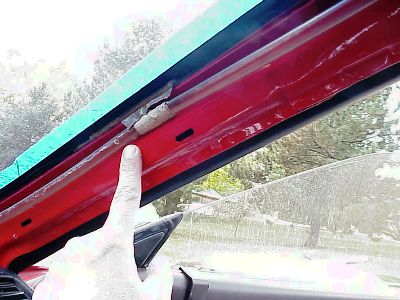 I also checked the T-top drain tube which runs under the passenger windshield pillar and over the ECU compartment. Remove the overlying trim piece by gently prying it loose. I also checked the T-top drain tube which runs under the passenger windshield pillar and over the ECU compartment. Remove the overlying trim piece by gently prying it loose.
The trim piece was held in place with prawls that inserted into three black ovals above, a couple of which can be seen above.
I also put a few silica dessicant packets I had laying around in the ECU compartment, and I sealed the edges of the ECU with clear packing tape. Hopefully, I will get more than a year out of this next ECU. Probably I had another failure because I replaced an old ECU with an old ECU, and not because of water leaking onto it, but who knows.
| 